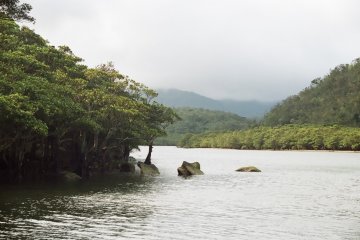The nearest island is Taiwan, located 68 miles (111km) away. Yonaguni has become one of Japan's most intriguing destinations for travelers from around the world. For scuba divers, there is a mysterious submerged site to explore; for animal lovers, Yonaguni's pony-like horses roam freely on the island.

Traditional crafts and artistic creations from Japan are well-known. Yonaguni is one of the regions to retain its own culture and ethnicity. Some ancient traditions remain vibrantly alive through the people who have chosen to stay. One of the outstanding products in Yonaguni is a potent alcoholic beverage called Hanasake that was used in sacred rituals in the past. Today, the local community dedicatedly passes on the ancestors' knowledge, and Yonaguni continues to preserve its cultural spirits.Thanks to devoted locals like Mr. Toshio Sakimoto, Mr. Hiroki Yonaha, and Mr. Ryuichi Ikema, who are passing their legacy on to succeeding generations.
The spirit and pride of Yonaguni people live on
Mr. Toshio Sakimoto, the fifth-generation owner of Sakimoto Sake Distillery, is doing more than just making sake — he’s preserving and promoting the cultural heritage of Yonaguni. As the head of the island’s oldest sake brewery, he not only protects traditional practices but also shares Yonaguni’s unique crafts and stories with the world.

Hanasake (花酒) is the strongest alcoholic beverage in Japan. The heart of Mr. Sakimoto’s work is Hanasake, which is part of Awamori, but labeled as spirit alcohol under the Japanese tax law.
Yonaguni is the only region in Japan where the Awamori spirit is produced and exported to Japan's main island and around the world. Interestingly, the nearest island is Taiwan, which is 111 km away, followed by Ishigaki at 117 km. With an alcohol content of 60%, the sake is renowned for its strength and purity, and Hanasake holds sacred value on the island and is considered one of Japan’s most iconic traditional spirits.

Awamori is made from rice, water, and black kōji mold, which is fermented and distilled to create a clear, rich spirit. For those familiar with shochu, rice-based Awamori offers a similar dry, smooth taste. Unlike Japanese sake, which tends to be sweeter and more aromatic, Awamori — especially Hanasake — is bold, crisp, and clean. “It’s almost like water and easy to drink,” Mr. Sakimoto says, describing its surprising smoothness despite its high alcohol content.
Mr. Sakimoto also shared with me a unique funeral tradition once practiced on the island. In the past, the deceased were buried without cremation, and two 1.8-liter bottles of Hanasake were placed in the grave. After seven years, the bones were exhumed for a bone-washing ceremony: one bottle was used to cleanse the bones before reburial, while the second was either consumed by the family in remembrance or kept for medicinal use. Hanasake, believed to have healing properties, was long thought to have both a spiritual and medicinal purpose.

When you scuba dive on Yonaguni, you will see many schools of fish. The kajiki fish, or marlin, is renowned in the fishing communities, and is an island mascot.

Mr. Hiroki Yonaha, a 40-year-old free-diving fisherman, is the only licensed fisherman of his kind in Yonaguni. He catches shrimp, shellfish, squid, and other sea products year-round for customers, and sometimes he swims long distances to serve customers’ requests. Yonaguni's population was estimated to be around 1,670 as of February 2025. Mr. Yonaha said he inherited his official license from his grandfather and is proud to be Yonaguni’s only free-diving fisherman.
To become a licensed free-diving fisherman like Mr. Yonaha, one must either inherit the official license from relatives or participate in a local fishing organization and pay some registration fees. Mr. Yonaha is proud of his heritage and feels dedicated to helping his island thrive. He left Yonaguni to go to high school in Okinawa’s mainland, then went to a university in Hyogo. When he turned 23, he came back to Yonaguni and became a free-dive fisherman.

After completing junior high school, students on Yonaguni must leave the island to attend high school in Ishigaki, Okinawa’s main island, or other prefectures. Many never return due to the lack of job opportunities. Mr. Sakimoto explained that he is now supported by his two sons, who have chosen to return home and carry on the family legacy. This is no small feat. He estimates that only about 20% of young people come back to the island. That both of his sons have returned, he says, is a stroke of luck — and a hopeful sign for the brewery’s future.

There once was a movement to establish a high school on Yonaguni Island. However, the island has intentionally chosen not to build a high school locally. Instead, it encourages all young people to leave the island at least once to get valuable experience elsewhere.

Preserving these traditions and ensuring the highest standards of craftsmanship is vital. However, selling products is not enough to preserve the island’s heritage. To pass on this knowledge to future generations, Mr. Ryuichi Ikema, a 74-year-old director of a history museum, continues to welcome visitors, especially local children, to his folk museum.

The museum was opened by his mother, Nae Ikema, who was born in 1919. She is one of the oldest Japanese people alive today. The more than 40-year-old museum serves as a space to display the island’s collection of historical items and share the knowledge and history with both visitors and younger generations. Mr. Ikema told me that his mother was afraid of losing the culture of Yonaguni's predecessors due to the rapid development after World War II, and so she supported experts and professors whenever they visited the island. She wrote a book about Yonaguni's history and ties with Taiwan. Some linguists visited her to study dialects that distinguish between Yonaguni itself and the Ryukyu Kingdom.


Keeping the spirits alive
Today, Yonaguni only has around 1,670 people living there, yet it continues to work to pass on its traditional culture and history to the next generation and to the world. Learning traditional skills, such as hataori (a weaving technique), is free, as the municipality supports and funds the training.

Being recognized as a local is a key part of the culture. Yonaguni’s traditional crafts are passed on only to those who are considered locals. People can be recognized as locals if they either marry a local or live on the island for more than five years. Like learning traditional weaving techniques, to become fishermen the municipality also subsidizes young people from other prefectures to obtain a fishing license on the island.
Making Awamori is also one of the most important traditions in Yonaguni. One of the other distilleries, Donan, was founded in 1958 and has maintained traditional brewing methods since the Ryukyu Kingdom era. The other is Sakimoto Sake Distillery, located at the western tip of the island. It was formally established in 1927, though Mr. Sakimoto’s ancestors were brewing alcohol as early as the late Meiji era.
Even its packaging is steeped in tradition: Bottles are wrapped in Kuba leaves, which provide natural cushioning for transport. This practice isn’t just practical — it’s a hallmark of Yonaguni’s craftsmanship and connection to nature. With traditions and skills that they are eager to preserve and pass on, the community, including in part by government funding, is coming together as one to ensure that these cultural treasures are carried into the next generation.



















